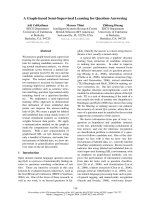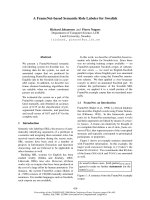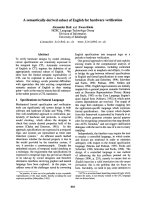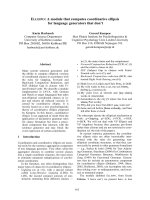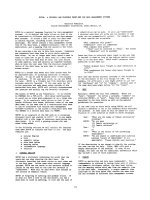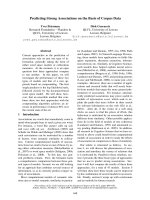Báo cáo khoa học: "A SYNTACTIC FILTER ON PRONOMINAL ANAPHORA FOR SLOT GRAMMAR" pdf
Bạn đang xem bản rút gọn của tài liệu. Xem và tải ngay bản đầy đủ của tài liệu tại đây (436.69 KB, 8 trang )
A SYNTACTIC FILTER ON PRONOMINAL ANAPHORA FOR SLOT GRAMMAR
Shalom Lappin and Michael McCord
IBM T.J. Watson Research Center
P.O. Box 704
Yorktown Heights, NY 10598
E-mail: Lappin/
ABS]RACT
We propose a syntactic falter for identifying
non-coreferential pronoun-NP pairs within a
sentence. The filter applies to the output of a
Slot Grammar parser and is formulated m terms
of the head-argument structures which the parser
generates. It liandles control and unbounded de-
pendency constructions without empty categories
or binding chains, by virtue of the uniticational
nature of the parser. The filter provides con-
straints for a discourse semantics system, reducing
the search domain to which the inference rules
of the system's anaphora resolution component
apply.
1. INTRODUCTION
In this paper we present an implemented al-
gorithm which filters intra-sentential relations of
referential dependence between pronouns and
putative NP antecedents (both full and pronomi-
nal NP's) for the syntactic representations pro-
vided by an English Slot Grammar parser
(McCord 1989b). For each parse of a sentence,
the algorithm provides a list o7 pronoun-NP pairs
where referential dependence of the first element
on the second is excluded by syntactic con-
straints. The coverage of the filter has roughly
the same extension as conditions B and C Of
Chomsky's (1981, 1986) binding theory, tlow-
ever, the formulation of the algorithm is sign!f" -
icantly different from the conditions of the
binding theory, and from proposed implementa-
tions of its conditions. In particular, the filter
formulates constraints on pronominal anaphora
in terms of the head-argument structures provided
by Slot Grammar syntactic representations rather
than the configurational tree relations, partic-
ularly c-command, .on which the binding theory
relies. As a result, the statements of the algorithm
apply straightforwardly, and without special pro-
vision, to a wide variety of constructions which
recently proposed implementations of the binding
theory do not handle without additional devices.
Like the Slot Grammar whose input it applies to,
the algorithm runs in Prolog, and it is stated in
essentially declarative terms.
In Section 2 we give a brief description of Slot
Grammar, and the parser we are employing. The
syntactic filter is presented in Section 3, first
through a statement of six constraints, each of
which is sufficient to rule out coreference, then
through a detailed description of the algorithm
which implements these constraints. We illus-
trate the/algorithm with examples of the lists of
non-corelerential pairs which it provides for par-
ticular parses. In Section 4 we compare our ap-
proach to other proposals for syntactic filtering
of pronominal anapliora which have appeared in
the literature. We discuss Ilobbs algorithm, and
we take UP two recent implementations of the
binding theory. Finally, in Section 5 we discuss
the integration of our filter into other systems of
anaphora resolution. We indicate how it can be
combined with a VP anaphora algorithm which
we have recently completed. We also outline the
incorporation of our algorithm into LODUS
(Bemth 1989), a system for discourse represen-
tation.
2. SLOT GRAMMAR
The original work on Slot Grammar was done
around 1976-78 and appeared in (McCord 1980).
Recently, a new version (McCord 1989b) was
developed in a logic programming framework, in
connection with fhe machine translation system
LMT (McCord 1989a,c,d).
Slot Grammar is lexicalist and is dependen-
cy-oriented. Every phrase has a head word (with
a given word sense and morphosyntactic fea-
tures). The constituents of a phrase besides tile
head word (also called the
modifiers
of the hcad)
are obtained by "Idling"
slots
associated with the
head. Slots are symbols like sub j, obj and iobj
representing grammatical relations, and are asso-
ciated with a word (sense) in two ways. The
lexical entry for the word specifies a set of
com-
plement
slots (corresponding to arguments of tile
word sense in logical form); and the grammar
specifies a set of
ad/unct
slots for each part of
135
speech. A complement slot can be filled at most
once, and an adjunct slot can by default be filled
any number of times.
The phenomena treated by augmented phrase
structure rules in some grammatical systems are
treated modularly by several different types of
rules in Slot Grammar. The most important type
of rule is the
(slot) filler
rule, which gives condi-
tions (expressed largely through unification) on
the filler phrase and its relations to the higher
phrase.
Filler rules are stated (normally) without ref-
erence to conditions on
order
among constitu-
ents. But there are separately stated
ordering
rules, l Slot~head
ordering rules state conditions
on the position (left or fight) of the slot (fdler)
relative to the head word.
Slot~slot
ordering rules
place conditions on the relative left-to-right order
of (the fillers of) two slots.
A slot is
obligatory
(not
optional)
if it must
be filled, either in the current phrase or in a raised
~osition through left movement or coordination.
djunct slots are always optional. Complement
slots are optional by default, but they may be
specified to be obligatory in a particular lexical
entry, or they may be so specifiedin the grammar
by
obligatory slot rules.
Such rules may be un-
conditional or be conditional on the character-
istics of the higher phrase. They also may specify
that a slot is obligatory
relative
to the idling of
another slot. For example, the direct object slot
in English. may. be d.eclared obligatory on the
conditmn that the indirect object slot is filled by
a noun phrase.
One aim of Slot Grammar is to develop a
p, owerful language-independent module, a
shell", which can be used together with lan-
guage-dependent modules, reducing the effort of
writing grammars for new languages. The Slot
Grammar shell module includes the parser, which
is a bottom-up chart parser. It also includes most
of the treatment of coordination, unbounded de-
pendencies, controlled subjects, and punctuation.
And the shell contains a system for evaluating
parses, extending tteidom's (1982)parse metric,
which is used not only for ranking final parses but
also for pruning away unlikely partial analyses
during
parsing, thus reducing the problem of
parse space explosion. Parse evaluation expresses
preferences for close attachment, for choice of
complements over adjuncts, and for parallelism
in coordination.
Although the shell contains
most
of the treat-
ment of the above .phenomena (coordination,
etc.), a small part of their treatment is necessarily
language-dependent. A (language-specific) gram-
mar can include for instance (1) rules for coordi-
nating feature structures that override the defaults
in the shell; (2) declarations of slots (called
ex-
traposer
slots) that allow left extraposition of
other slots out oI their fdlers; (3) language-specific
rules for punctuation that override defaults; and
(4) language-specific controls over parse evalu-
ation that override defaults.
Currently, Slot Grammars are being devel-
oped for English (ESG) by McCord, for Danish
(DSG) by Arendse Bemth, and for German
(GSG) by Ulrike Schwall. ESG uses the UDIC'F
lexicon (Byrd 1983, Klavans and Wacholder
1989) having over 60,000 lemmas, with an inter-
face that produces slot frames. The fdter
algo-
rithm
has so far been successfully tested with
ESG and GSG. (The adaptation to German was
done by Ulrike Schwall.)
The algorithm applies in a second pass to the
parse output, so the important thing in the re-
mainder of this section is to describe Slot Gram-
mar syntactic analysis structures.
A syntactic structure is a tree; each node of
the tree represents a phrase in the sentence and
has a unique head word. Formally, a phrase is
represented by a term
phrase(X,H,Sense,Features,
s
IotFrame,Ext,Hods),
where the components are as follows: (1)
X
is a
logical variable called the
marker
of the phrase.
U/aifications of the marker play a crucial role in
the fdter algorithm. (2) H is an integer repres-
enting the position of the head word o f the
phrase. This integer identifies the phrase
uniquely, and is used ha the fdter algorithm as the
way of referring to phrases. (3) Sense is the
word sense of the head word. (4) Features is
the feature structure of the head word
and
of the
phrase. It is a logic term (not an attribute-value
list), which is generally rather sparse ha informa-
tion, showing mainly the part of speech and in-
flectional features of the head word. (5)
5 l otFrame is the list of complement slots, each
slot being ha the internal form
s Iot(S iot,0b,X), where Slot is the slot name,
0b shows whether it is an obligatory form of
Slot, and X is the
slot marker.
The slot marker
is unified (essentially) with the marker of the filler
phrase when the slot is fdled, even remotely, as
in left movement or coordination. Such unifica-
tions are important for the filter algorithm. (6)
Ext is the list of slots that have been
extraposed
or
raised
to the level of the current phrase. (7)
The last component Hods represents the modifi-
ers (daughters) of the phrase, and is of the form
mods (LHods, RMods )
where
LHods and RMods
are
Tile distinction between slot filler rules and ordering constraints parallels the difference between Immediate Do-
minance Rules and Linear Precedence Rules in GPSG. See Gazdar et al (1985) for a characterization of ID and
I,P rules in GPSG. See (McCord 1989b) for more discussion of the relation of Slot Grammar to other systems.
136
Who did John say wanted to try to find him?
subj(n)
top
subj(n)
auxcmp(inf(bare))
obj(fin)
preinf
comp(enlinfling)
~
preinf
obj(inf)
obj(fin)
who(X2) noun
dol(Xl,X3,X4) verb
John(X3) noun
say(X4,X3,Xg,u) verb
want(X9,X2,X2,Xl2) verb
preinf(Xl2) preinf
try(Xl2,X2,Xl3) verb
preinf(Xl3) preinf
find(Xl3,X2,Xl4,u,u) verb
he(Xl4) noun
Figure i.
the lists of left modifiers and right modifiers, re-
spectively. Each member of a modifier list is of
the form
Slot:Phrase
where Slot is a slot and
Phrase is a phrase which flUs Slot. Modifier
lists reflect surface order, and a given slot may
appear more than once (if it is an adjunct). Thus
modifier lists are not attribute-value lists.
In Figure 1, a sample parse tree is shown,
displayed by a procedure that uses only one line
per node and exhibits tree structure lines on the
left. In this display, each line (representing a
node) shows (1) the tree connection fines, (2) the
slot filled by the node, (3) the
word sensepredi-
cation,
and (4) the feature structure. The feature
structure is abbreviated here by a display option,
showin8 only the part of speech. The word sense
predication consists of the sense name of the head
word with the following arguments. The first ar-
gument is the marker variable for the phrase
(node) itself; it is like an event or state variable for
verbs. The remaining arguments are the marker
variables of the slots in the complement slot
frame (u signifies "unbound"). As can be seen in
the display, the complement arguments are uni-
fied with the marker variables of the fdler com-
plement phrases., Note that in the example the
marker X2 ol the who phrase is unified with the
subject variables of want, try, and find.
(There are also some unifications created by ad-
junct slot Idling, which will not be described
here.)
Forthe operation of the filter algorithm, there
is a prelim~ary step in which pertinent informa-
tion about the parse tree is represented in a man-
ner more convenient for the algorithm. As
indicated above, nodes (phrases) t]lemselves are
represented by the word numbers of their head
words. Properties of phrases and relations be-
tween them are represented by unit clauses
(predications) involving these integers (and other
data), which are asserted into the Prolog work-
space. Because of this "dispersed" representation
with a collection of unit clauses, the original
phrase structure for the whole tree is first
grounded (variables are bound to unique con-
stants) before the unit clauses are created.
As an example for this clausal representation,
the clause has ar g (P, X) says that phrase P has X
one of its arguments;
i.e.,
X is the slot marker
variable for one of the complement slots of P.
For the above sample parse, then, we would get
clauses
hasarg(5,'X2'), hasarg(5,'Xl2').
as information about the "want' node (5).
As another example, the clause
phmarker(P,X)
is added when phrase
P
has
marker X. Thus for the above sample, we would
get the unit clause
phmarker(I,'X2').
An important predicate for the fdter algorithm
is
argm,
defined by
argm(P,Q) *- phmarker(P,X)
&
hasarg(Q,X).
This says that phrase
P
is an argument of phrase
Q. This includes remote arguments and con-
trolled subjects, because of the unifications of
marker variables performed by the Slot Grammar
parser. Thus for the above parse, we would get
argm(1,5), argm( 1,7). argm( I ,9).
showing that 'who' is an argument of 'want', "try',
and "find'.
3. THE FILTER
137
A.
A.I.
B.
B.I.
C.
C.l.
a.
b.
C.
d.
e.
£.
C.2.
C.2.1.
C.2.2.
C.3.
D.
D.I.
E.
E.I.
Fo
F.I
The Filter Algorithm
nonrefdep(P,Q) ~ refpair(P,Q) & ncorefpair(P,Q).
refpair(P,Q) ~ pron(p) & noun(Q) & P=/Q.
ncorefpair(P,Q) ~ nonagr(P,Q) &/.
nonagr(P,Q) ~ numdif(p,Q) I typedif(P,Q) I persdif(P,Q).
ncorefpair(P,Q) ~ proncom(P,Q) &/.
proncom(P,Q)
argm(P,H) &
(argm(Q,H) &/ I
-pron(Q) &
cont(Q,H) &
(-subclcont(Q,T) I gt(Q,p)) &
(~det(Q) I gt(Q,P))).
cont_i(P,Q) ~ argm(P,Q) I adjunct(P,Q).
cont(P,Q) ~ cont_i(P,Q).
cont(P,Q) ~ cont_i(P,R) & R=/Q & cont(R,Q).
subclcont(P,Q) ~ subconj(Q) & cont(P,Q).
ncorefpair(P,Q) ~ prepcom(Q,P) &/.
prepcom(Q,P) ~ argm(Q,H) & adjunct(R,H) & prep(R) & argm(P,R).
ncorefpair(P,Q) ~ npcom(P,Q) &/.
npcom(Q,P) ~ adjunct(Q,H) & noun(H) &
(argm(P,H) [
adjunct(R,H) & prep(R) & argm(P,R)).
ncorefpair(P,Q) ~ nppcom(P,Q) &/.
nppcom(P,Q) ~ adjunct(P,H) & noun(H) &
-pron(Q) & cont(Q,H).
Figure 2.
In preparation for stating the six constraints,
we adopt the following definitions. The agree-
ment features of an NP are its number, person
and gender features. We will say that a phrase P
is in the argument domain of a phrase N iff P an
N are both arguments of the same head. We will
also say that Pis in the adjunct domain of N iff
N is an argument of a head tt, P is the object of
a preposition PREP, and PREP is an adjunct of
It. P is in the NP domain of N iff N is the det-
erminer of a noun Qand (i) P is an argument of
Q, or (ii) P is the object of a preposition PREP
and Prep is an adjunct of Q. The six constraints
are as follows. A pronoun P is not coreferential
with a noun phrase N if any of the following
conditions holds.
I. P and N have incompatible agreement features.
II. P is in the argument domain of N.
III. P is in the adjunct domain of N.
IV. P is an argument of a head H, N is not a
pronoun, and N is contained in tt.
V. P is in the NP domain of N.
VI. P is the determiner of a noun Q, and N is
contained in Q.
The algorithm wlfich implements I-VI defines a
predicate nonrefdep(P,q) wlfich is satisfied by
a pair whose first element Is a pronoun and whose
second element is an NP on which the pronoun
cannot be taken as referentially dependent, by
virtue of the syntactic relation between them.
The main clauses of the algorithm are shown in
Figure 2.
Rule A specifies that the main goal
nonrefdep(P,Q)
is satisfied by
<P ,Q> if
this pair
is a referential pair (refpalr(P,Q)) and a non-
coreferential pair (neorefpair(P,Q)). A.1 de-
frees a refpatr ,:P,Q> as one in which P is a
pronoun, Q'is a noun (either pronominal or non-
pronominal), and P and Q are distinct. Rules B,
C, D, E, and F provide a disjunctive statement
of the conditions under which the non-corefer-
ence goal ncorefpair(P,Q) is satisfied, and so
const,tute the core of the algorithm. Each of
these rules concludes with a cut to prevent un-
necessary backtracking which could generate
looping.
Rule B, together with B. I, identifies the con-
ditions under which constraint I holds. In the
following example sentences, the pairs consisting
of the second and the first coindexed expressions
in la-c (and in lc also the pair < T,'she'> ) sat-
isfy nonrefdep(P,Q) by virtue of rule B.
la. John i said that they i came.
138
b. The woman i said that
he i
is funny.
C. I i
believe that
she i
is competent.
• " • ~, t, •
The algorithm Identifies they, John > as a
nonrefdep pair in la, which entails that 'they,
cannot be taken as coreferential with John.
However, (the referent of) "John" could of course
be part of the reference set of 'they, and in suit-
able discourses LODUS could identify this possi-
bility.
Rule C states that <P ,Q> is a non-coreferential
pl.~i.r, if it satisfies the pro ncom(P,Q) predicate.
s holds under two conditions, corresponding
to disjuncts C. 1.a-b and C.l.a,c-f. The first con-
dition specifies that the pronoun P and its puta-
tive antecedent Q are both arguments of the same
phrasal head, and so implements constraint II.
This rules out referential dependence in 2a-b.
2a. Mary i likes her i.
b.
She i
tikes her i.
Given the fact that Slot Grammar unifies the ar-
gument and adjunct variables of a head with the
phrases which t'dl these variable positions, it will
also exclude coreference in cases of control and
unbounded dependency, as in 3a-c.
3a. Jolt. seems to want to see hirn~
b. Whi6h man i did he i see?
e. This is the girl i. Johh said she i saw.
The second disjunct C.l.a,c-f covers cases in
which the pronoun is an argument which is
higher up in the head-argument structure of the
sentence than a non-pronominal noun. This dis-
junct corresponds to condition IV. C.2-C.2.2
provide a reeursive definition of containment
within aphrase. This definition uses the relation
of immediate containment, eont i (P ,Q), as the
base of the recursion, where con~ i (P ,Q) holds
if Q is either an argument or an adj'unct (modifier
or determiner) of a head Q. The second disjunct
blocks coreference in 4a-c.
4a. He~ believes that the m.a% is amusing.
b. Who i did he i say Johr~. hssed?
c. This Is the man i he i said John i
wrote about.
The wh-phrase in 4b and the head noun of the
relative clause in 4c unify with variables in posi-
tions contained within the phrase (more precise!y,
the verb which heads the phrase) of which the
pronoun is an argument. Therefore, the algo-
rithm identifies these nouns as impossible ante-
cedents of the pronoun.
The two final conditions of the second dis-
junct, C. 1 .e and C. l.f, describe cases in which the
antecedent of a pronoun is contained in a pre-
ceding adjunct clause, and cases in which the an-
tecedent is the determiner of an NP which
precedes a pronoun, respectively. These clauses
prevent such structures from satisfying the non-
coreference goal, and so permit referential de-
pendence in 5a-b.
5a. After John i sang, he i danced.
b. Johni's motherlikes him i.
Notice that because a determiner is an adjunct of
an NP and not an argument of the verb of which
the NP is an argument, rule C. 1 also permits co-
reference in 6.
6. His i mother likes John i.
ltowever, C.l.a,c-e correctly excludes referential
dependence in 7, where the pronoun is an argu-
ment which is higher than a noun adjunct.
7. He i likes Johni's mother.
The algorithm permits backwards anaphora in
cases like 8, where the pronoun is not an argu-
ment of a phrase 14 to wtfich its antecedent Q bears
the con t (Q, fl ) relation.
8. After he i sang, John i danced.
D-D.I block coreference between an NP
which is the argument of a head H, and apronoun
that is the object of a preposition heading a PP
adjunct of 14, as in 9a-c. These rules implement
constraint III.
9a. Sam. i spoke about him i.
b. She i sat near her i.
C. Who i
did he i ask for?
Finally, E-E.I and F realize conditions V and
VI, respectively, in NP internal non-coreference
cases like 10a-c.
10a. His i portrait of Jo .hnj. is interesting.
b. JolL, i/s portrait of htrn i is interestmg.
c. Hisi description of the portrait by John i
is interesting.
Let us look at three examples of actual lists
of pairs satisfying the nonrefdep predicate which
the algorithm generates for particular parse trees
of Slot Grammar. The items in each pair are
identified by their words and word numbers, cor-
responding to their sequential position in the
stnng.
When the sentence Who did John say
wanted to try to find him? is ~ven to
the system, the parse is
as
shown in Figure 1
above, and the output of the filter is:
Noncoref pairs:
he.lO - who.l
139
Coreference
analysis time = ii msec.
Thus < "him','who' > is identified as a non-core-
ferential pair, while coreference between 'John'
and 'him is allowed.
In Figure 3, the algorithm correctly lists
< 'him ,'Bill > (6-3) as a non-coreferential pair,
while permitting 'him' to take "John' as an ante-
cedent. In Fi~c~ure 4, it correctly excludes corefer-
ence between him and 'John' (he.6-John.1), and
allows him to be referentially dependent upon
"Bill'.
John expected Bill to impress him.
I
I
subj(n) John(X3) noun
top expect(Xl,X3,X4,X5) verb
obj Bill(X4) noun
preinf preinf(X5) preinf
comp(inf) impress(XS,X4,X6) verb
obj he(X6) noun
Noncoref pairs :
he.6 - Bill.3
Coreference analysis time = 5
msec.
complement clause subiect, tlowever, in Figure
4, the infinitival clause IS an adjunct of 'lectured'
mid requires matrix subject control.
4. EXISTING PROPOSALS FOR CON-
STRAINING PRONOMINAL ANAPHORA
We will discuss three suggestions which have
been made in the computational literature for
syntactically constraining the relationship be-
tween a pronoun and its set of possible antece.
dents intra-sententially. The first is Hobbs
(1978) Algorithm, which performs a breadth-first,
left-to-right search of the tree containing the pro-
noun for possible antecedents. The search is re-
stricted to paths above the first NP or S node
containing the pronoun, and so the pronoun
cannot be boundby an antecedent in its minimal
governing category. If no antecedents are found
within the same tree as the pronoun, the trees of
the previous sentences in the text are searched in
order of proximity. There are two main .difficul-
ties with this approach. First, it cannot be ap-
plied to cases of control in infinitival clauses, like
those given in Figures 3 and 4, or to unbounded
dependencies, like those in Figure 1 and in ex-
amples 3b-c and 4b-c, without significant modifi-
cation.
Figure 3.
John lectured Bill to impress him.
! subj(n) John(X3) noun
• top lecture(Xl,X3,X4) verb
[ obj Bill(X4) noun
~ preinf preinf(X5) preinf
vnfvp impress(X5,X3,X6) verb
obj he(X6) noun
Noncoref pairs:
he.6 - John.l
Coreference analysis time = 5
msec.
Figure 4.
It makes this distinction by virtue of the differ-
ences between the roles of the two infinitival
clauses in these sentences. In Fi~gtjre 3, the infin-
itival clause is a complement o1 "expected, and
this verb is marked for object control of the
Second, the algorithm is inefficient in design
and violates modularity by virtue of the fact that
it computes both intra-sentential constraints on
pronoriainal anaphora and inter-sentential ante-
cedent possibilities each time it is invoked for a
new pronoun in a tree. Our system computes the
set ofpronoun-NP pairs for which coreference is
syntactically excluded in a single pass on a parse
tree. This set provides the input to a semantic-
pragmatic discourse module which determines
anaphora by inference and preference rules.
The other two proposals are presented in
Correa (1988), and in lngria and Stallard (1989).
Both of these models are implementations oI
Chomsky's Binding theory which make use of
Government Binding type parsers. They employ
essentially the same strategy. This involves com-
puting the set of possible antecedents of an ana-
phor as the NP s which c-command the anaphor
within a minimal domain (its minimal govet:ning
category). 2 The minimal domain of an NP is
characterized as the first S, or the first NP without
a possessive subiect, in which it is contained. The
possible intra-sentential antecedents of a pronoun
are the set of NP's in the tree which are not in-
cluded within this minimal domain.
See Reinhart (1976) and (1983) for alternative definitions of c-command, and discussions of the role of this re-
lation in determining the possibilities of anaphora. See Lappin (1985) for additional discussion of the connection
between c-command and distinct varieties of pronominal anal3hora. See Chomsky (1981), (1986a) and (1986b)
for alternative definitions of the notion 'government' and 'rain,real governing category'.
140
This approach does sustain modularity by
computing the set of possible antecedents for all
pronouns within a tree in a single pass operation,
prior to the application of inter-sentential search
procedures. The main difficulty with the model
is that because constraints on pronominal ana-
phora are stated entirely in terms of configura-
tional relations of tree geometry, specifically, in
terms of c-command and minimal dominating S
and NP domains, control and unbounded de-
p
endency structures can only be handled b~' ad-
itional and fairly complex devices. It is
necessary to generate empty categories for PRO
and trace in appropriate positions in parse trees.
Additional algorithms must be invoked to specify
the chains of control (A-binding) for PRO, and
operator (A )-binding for trace in order to link
these categories to the constituents which bind
them. The algorithm which computes possible
antecedents for anaphors and pronouns must be
formulated so that ii identifies the head of such a
chain as non-coreferential with a pronoun or
anaphor (in the sense of the Binding theory), if
any element of the chain is excluded as a possible
antecedent.
Neither empty categories nor binding chains
are required in our system. In Slot Grammar
parse representations, wh-phrases, heads of rela-
tive clauses, and NP's which control the subjects
of inf'mitival clauses are unified with the variables
corresponding to the roles they bind in argument
positions. Tlierefore, the clauses of the algorithm
apply to these constructions directly, and without
additional devices or stipulations)
5. THE INTEGRATION OF THE FILTER
INTO OTHER SYSTEMS OF ANAPHORA
RESOLUTION
We have recently implemented an algorithm
for the interpretation of intrasentential VP ana-
phora structures like those in 1 la-c.
1 l a. John arrived, and Mary did too.
b. Bill read every book which Sam said
he did.
c. Max wrote a letter to Bill before Mary
did to John.
The VP anaphora algorithm generates a second
tree which copies the antecedent verb into the
position of the head of the elliptical VP. It also
lists the new arguments and adjuncts which the
copied verb inhei'its from its antecedent. We have
integrated our filter on pronominal anaphora into
this algorithm, so that the filter applies to the in-
terpreted trees which the algorithm generates.
consider
12. John likes to him, and Bill does too.
If the [dter applies to the parse of 11, it will
identify only .< him, John'> as a non-corefer-
ential pair, gwen that the pair <'him','Bill'>
doesn t satisfy any of the conditions of the filter
algorithm. Ilowever, when the filter is applied to
the interpreted VP anaphora tree of 12, the filter
algorithm correctly identifies both pronoun-NP
pairs, as shown in the VP output of the algorithm
for 12 given in Figure 5.
John likes him, and Billdoes too.
Antecedent Verb-Elliptical Verb Pairs.
like.2 - dol.7
Elliptical Verb-New Argument Pairs.
like.7 - he.3
Interpreted VP anaphora tree.
subj John(X9) noun
~ iconj like(X8,X9,Xl0) verb
obj he(Xl0) noun
• top and(Xi,X8,Xll) verb
~
subj BilI(XI2) noun
rconj like(Xll,Xl2,Xl0) verb
vadv too(Xll) adv
Non-Coreferential Pronoun-NP Pairs.
he.3 - John.l, he.3 - Bill.6
Coreference analysis time = 70 msec.
Figure 5.
Our filter also provides input to a discourse
understanding system, LODUS, designed and
implemented by A. Bernth, and described in
( Bernth 1988, 1989). LOI)US creates a single
discourse structure from the analyses of the S|0t
Grammar parser for several sentences. It inter-
prets each sentence analysis in the context con-
sisting of the discourse processed so far, together
with domain knowledge, and it then embeds it
into the discourse structure. The process of in-
te.rpretation consists in applying rules of inference
which encode semantic and pragmatic (know-
In fact, a more complicated algorithm with approximately tile same coverage as our lilter can be formulated fi, r
a parser which produces configurational surlhce trees wiulout empty categories and binding chains, if the parser
provides deep grammatical roles at some level of representation. The first author has implemented such an al-
gorithm for the PEG parser. For a general description of I'EG, see Jensen (1986). The current version of ['E(;
provides information on deep grammatical roles by means of second pass rules which apply to the initial parse
record structure. The algorithm employs both c-command and reference to deep grammatical roles.
141
ledge-based) relations among lexical items, and
discourse structures. The fdter reduces the set oI
possible antecedents which the anaphora resol-
ution component of LODUS considers for pro-
nouns. For example, this component will not
consider 'the cat or that' as a .p, ossible antece-
dents for either occurrence of it in the second
sentence in 13, but only "the mouse' in the first
sentence of this discourse. This is due to the fact
that our fdter lists the excluded pairs together
with the parse tree of the second sentence.
13. The mouse ran in.
The cat that saw it ate it.
Thus, the fdter significantly reduces the search
space which the anaphora resolution component
of LODUS must process. The interface between
our filter and LODUS embodies the sort of mo-
dular interaction of syntactic and semantic-prag-
matic components which we see as important to
the successful operation and efficiency of any
anaphora resolution system.
ACKNOWLEDGMENTS
We are grateful to Arendse Bemth, Martin
Chodorow, and Wlodek Zadrozny for helpful
comments and advice on proposals contained in
this paper.
REFERENCES
Bemth, A. (1988) Computational Discourse Se-
mantics, Doctoral Dmsertation, U. Copenha-
gen and IBM Research.
Bemth, A. (1989) "Discourse Understanding In
Lo~c", Proc. North American Conference on
Logic Programming, pp. 755-771, MIT Press.
Byrd, R. J. (1983) "Word Formation in Natural
Language Processing Systems," Proceedings
oflJCAI-VIII, pp. 704-706.
Chomsky, N. (1981) Lectures on Government and
Binding, Foils, Dordrecht.
Chomsky, N. (1986a) Knowledge of Language:
Its Nature, Origin, and Use, Praeger, New
York.
Chomsky, N. (1986b) Barriers, MIT Press,
Cambridge, Mass.
Correa, N. (1988) "A B'_m,,ding Rule for Govern-
ment-Binding Parsing , COLING "88, Buda-
pest, pp. 123-129.
Gazdar, G., E. Klein, G. Pullum, and I. Sag,
G1985) Generalized Phrase Structure
rammar, Blackwell, Oxford.
Heidorn, G. E. (1982) "Experience with an Easily
Computed Metric for Ranking Alternative
Parses," Proceedings of Annual ACL Meeting,
1982, pp. 82-84.
I tobbs, J.
(1978)
j'Resolving l'ronoun
References", Lingua 44, pp. 311-338.
Ingria, R. and D. Stallard (1989) "A Computa-
tional Mechanism for Pronominal
Reference", Proceedings of the 27th Annual
Meeting of the Association for Computational
Linguistics, Vancouver, pp. 262-271.
Jensen, K. (,1986) "PEG: A Broad-Coverage
Computatmnal Syntax of English," Technical
Report, IBM T.J. Watson Research Center,
Yorktown Heights, NY.
Klavans, J. L. and Wacholder, N. (1989) "Doc-
umentation of Features and Attributes in
UDICT," Research Report RC14251, IBM
T.J. Watson Research Center, Yorktown
Heights, N.Y.
Lappin, S. (1985) "Pronominal Binding and Co-
reference", Theoretical Linguistics 12, pp.
241-263.
McCord, M. C. (1980) "Slot Grammars," Com-
putational Linguistics, vol. 6, pp. 31-43.
McCord, M. C. (1989a) "Design of LMT: A
Prolog-based Machine Translation System,"
Computational Linguistics, vol. 15, pp. 33-52.
McCord, M. C. (1989b) "A New Version of Slot
Grammar," Research Report RC 14506, IBM
Research Division, Yorktown Iteights, NY
10598.
McCord, M. C. (198%) "A New Version of the
Machine Translation System LMT," to ap-
pear in Proc. International Scientific Sympo-
sium on Natural Language and Logic, Springer
Lecture Notes in Computer Science, and in
J. Literary and Linguistic Computing.
McCord, M. C. (1989d) "LMT," Proceedings of
MT Summit II, pp. 94-99, Deutsche GeseU-
schaft f'tir Dokumentation, Frankfurt.
Reinhart, T. (1976) The Syntactic Domain of
Anaphora, Doctoral Dissertation, MIT, Cam-
bridge, Mass.
Reinhart, T. (1983) Anaphora, Croom
Ilelm,
London.
142
